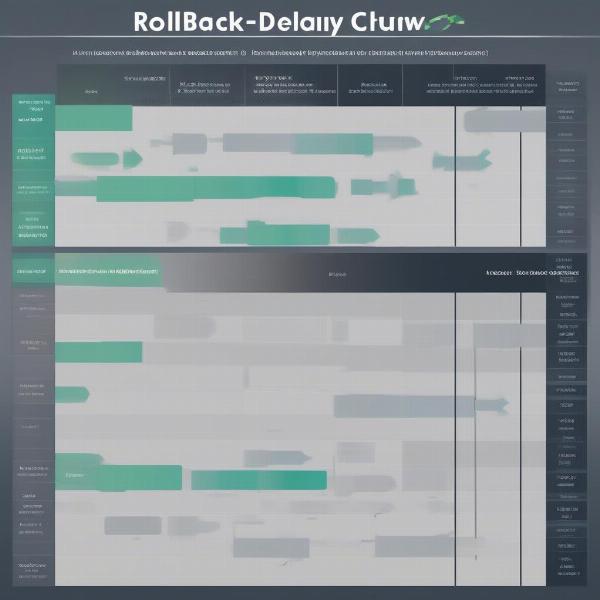Rollback netcode is a revolutionary technique used in online fighting games to create a smoother and more responsive experience, even with high latency. It essentially predicts your inputs and displays the action locally, then corrects any discrepancies caused by lag. This differs drastically from the traditional delay-based netcode, which often leads to frustrating pauses and delayed reactions.
Understanding Rollback Netcode: A Deep Dive
Rollback netcode represents a significant advancement in online fighting game technology. Instead of waiting for confirmation from the opponent’s machine with every input, as with delay-based netcode, rollback netcode anticipates your actions based on your previous inputs. It then renders the game locally, creating a seamless experience. When information from the opponent arrives, the game checks for discrepancies. If the prediction was incorrect, the game quickly “rolls back” to the correct state and displays the adjusted action. This process often happens so quickly that it’s nearly imperceptible to the player, resulting in a much more responsive and fluid online match.
How Does Rollback Netcode Improve the Online Experience?
Rollback netcode dramatically enhances the online fighting game experience by minimizing the negative impact of lag. It allows for faster reactions, more accurate inputs, and a generally more enjoyable experience. This is particularly important in fighting games where precise timing and frame-perfect inputs are crucial for success. With delay-based netcode, high latency can lead to delayed reactions and missed inputs, making online play feel sluggish and unresponsive. Rollback netcode addresses these issues by prioritizing local responsiveness, making online matches feel much closer to offline play.
Delving into the Mechanics of Rollback
The core of rollback netcode lies in its predictive capabilities. The game constantly anticipates your next move based on your current input and past behavior. This prediction allows the game to be rendered locally, providing a near-instantaneous response to your actions. When data from your opponent’s machine arrives, the game compares it with its prediction. If a discrepancy is detected, a rollback occurs, quickly correcting the game state to reflect the actual events. The efficiency of rollback netcode comes from its ability to perform these corrections seamlessly, often without the player even noticing.
The Advantages of Rollback Over Delay-Based Netcode
The advantages of rollback netcode over delay-based netcode are numerous and significant, particularly for fighting games. Rollback netcode provides a much more responsive and consistent online experience, minimizing the frustrating lag and delays common with delay-based approaches. This allows for more precise inputs and reactions, leading to fairer and more competitive online matches. While rollback netcode is not a perfect solution and can still be affected by extreme latency, it represents a considerable improvement over traditional methods.
 Rollback Netcode Diagram in Fighting Games
Rollback Netcode Diagram in Fighting Games
Why is Rollback Netcode so Important in Fighting Games?
The importance of rollback netcode in fighting games stems from the genre’s inherent reliance on precise timing and reactions. Every frame counts in a fighting game, and even slight delays can drastically alter the outcome of a match. Rollback netcode mitigates the impact of lag by prioritizing local responsiveness, ensuring that your inputs are registered as accurately as possible, regardless of network conditions. This makes online matches feel much more fluid and responsive, closer to the experience of playing offline.
Common Misconceptions about Rollback Netcode
While rollback netcode has become increasingly popular, some misconceptions still surround its functionality. One common misconception is that rollback netcode eliminates lag entirely. While it significantly reduces the perceived lag and improves responsiveness, it cannot completely eliminate the effects of high latency. Another misconception is that rollback netcode is universally superior in all situations. While it is generally preferred for fighting games, other genres may benefit more from different netcode solutions.
 Rollback vs. Delay-Based Netcode Comparison
Rollback vs. Delay-Based Netcode Comparison
“Rollback netcode has truly revolutionized the online fighting game landscape. It’s no longer a luxury, but a necessity for competitive play.” – David “EvoDave” Evans, Fictional Fighting Game Community Analyst
The Future of Rollback Netcode in Fighting Games
Rollback netcode is becoming the standard for online fighting games, and its continued development promises even further improvements in the future. As technology advances and internet infrastructure improves, we can expect even smoother and more responsive online experiences. The widespread adoption of rollback netcode signifies a major step forward for the fighting game community, enabling a more connected and competitive online environment.
How to Identify Games with Rollback Netcode
Identifying games with rollback netcode is becoming increasingly straightforward as more developers embrace the technology. Many games explicitly advertise their use of rollback netcode as a selling point. You can often find information about a game’s netcode implementation on its official website, in online forums, or through community discussions. Reviews and articles about fighting games often mention the type of netcode used, providing another resource for discerning which games utilize rollback.
“The impact of rollback netcode on the fighting game community cannot be overstated. It’s brought players together from all over the world, fostering a truly global competitive scene.” – Samantha “SamFGC” Lee, Fictional Fighting Game Tournament Organizer
Optimizing Your Setup for Rollback Netcode
While rollback netcode handles much of the heavy lifting in mitigating lag, optimizing your setup can further enhance your online experience. A stable and low-latency internet connection is essential for minimizing discrepancies and ensuring smooth gameplay. Using a wired connection instead of Wi-Fi is highly recommended, as wired connections generally offer lower latency and greater stability. Closing unnecessary applications running in the background can also help free up system resources and improve performance.
Conclusion
Rollback netcode has become a game-changer for online fighting games, offering a significantly improved experience compared to traditional delay-based methods. By predicting inputs and correcting discrepancies, rollback minimizes the negative impact of lag, enabling a more responsive and competitive online environment. Understanding What Is Rollback In Fighting Games is crucial for any fighting game enthusiast looking to elevate their online play. So, embrace the power of rollback and experience the next level of online fighting game action!

